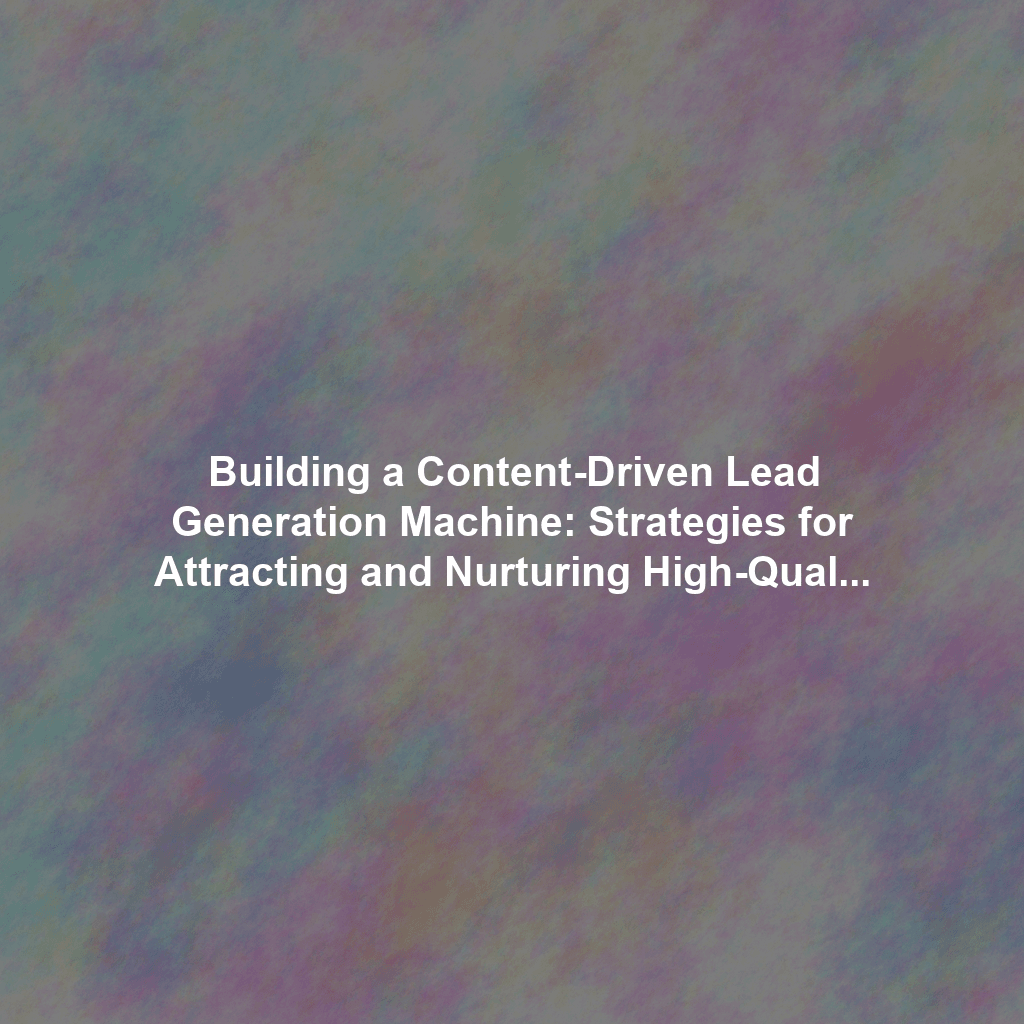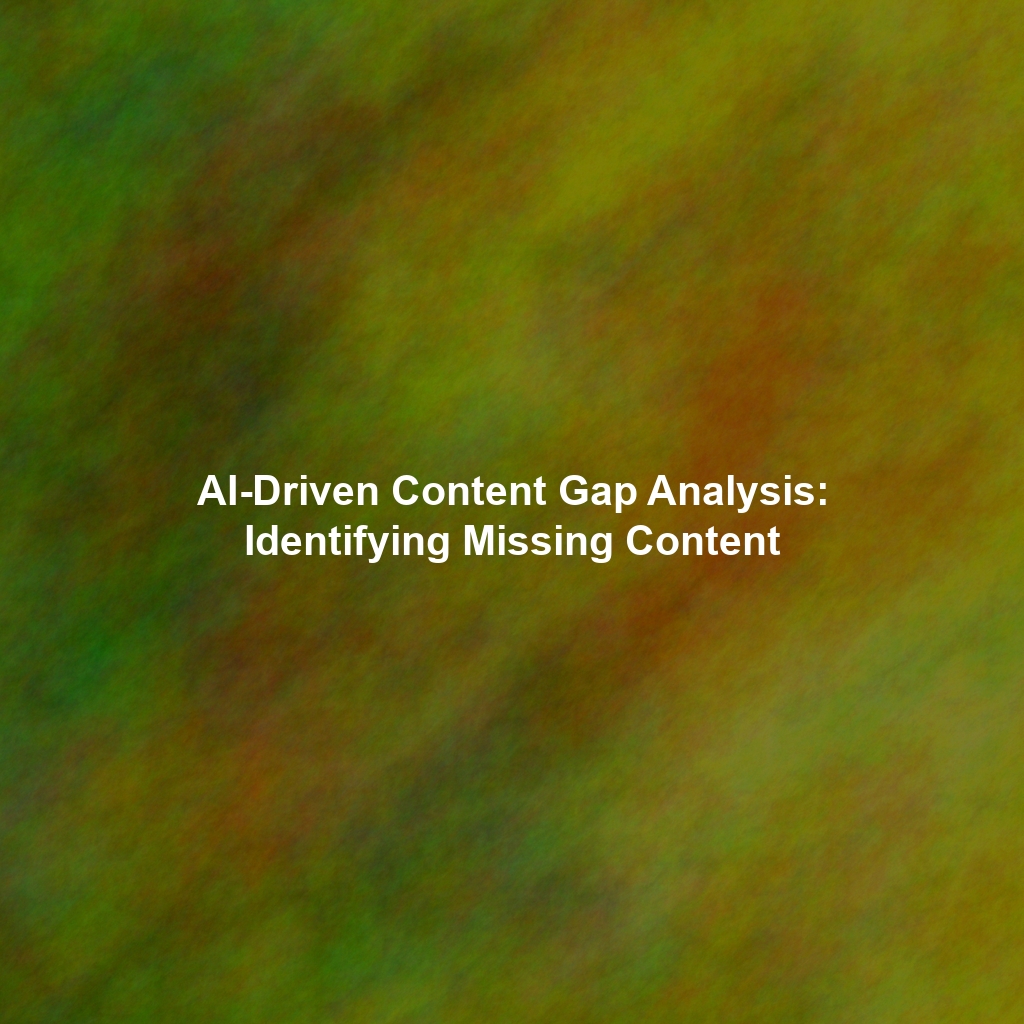This perception, however, fundamentally misunderstands its profound potential. What if, instead of viewing content as a drain on resources, you could transform your entire content strategy into a powerful, self-sustaining engine for generating high-quality leads and driving exponential revenue growth? From my vantage point, steeped in a Dartmouth math degree, an MBA from Harvard Business School, and a career focused on maximizing ROI at entities like McKinsey, Bain Capital, and as CEO of Ideascale, I can unequivocally state that content, when strategically deployed, is not an expense; it is an investment with a demonstrable and compelling return. This article provides a meticulous, step-by-step guide to constructing a content-driven lead generation machine, focusing on data-informed strategies that precisely attract the right audience, nurture them with unparalleled effectiveness, and ultimately convert them into loyal, paying customers.
The digital landscape is not merely a marketplace; it is a battleground for attention and trust. In this arena, generic content fades into obscurity. The strategic imperative is to craft content that not only educates and engages but also systematically guides prospects through their buyer’s journey, transforming interest into intent, and intent into revenue. This demands a shift from a broad-brush approach to content creation to a highly targeted, analytical methodology. The goal is to build a predictable, scalable system where content acts as the primary catalyst for lead acquisition and conversion, directly contributing to your organization’s bottom line. This isn’t about hoping for leads; it’s about engineering them.
Defining Your Ideal Customer and Architecting a Precision Content Strategy
Before a single piece of content is conceived, the foundational step is to establish a crystal-clear, almost forensic, understanding of your Ideal Customer Profile (ICP). This is not a superficial exercise; it is a deep dive into the very essence of who benefits most from your offerings. Who are they, precisely? What are their most acute pain points, their overarching goals, and their daily operational challenges? What specific information are they actively seeking to alleviate these challenges or achieve those goals? A failure to define your ICP with granular precision is a direct path to wasted content resources and diluted marketing efforts.
Creating Detailed Buyer Personas: The Human Face of Your ICP
Once your ICP is defined, the next critical step is to develop detailed buyer personas. These are semi-fictional representations of your ideal customers, grounded in real data and informed insights. Give them names, assign them specific roles within their organizations, delineate their responsibilities, and articulate their unique characteristics. This detailed understanding will serve as the bedrock for your entire content strategy, ensuring that every piece of content you create resonates deeply with the right audience segments. A robust persona should include:
- Demographics: Age, gender, location, income, education level.
- Firmographics (for B2B): Company size, industry, revenue.
- Job Role & Responsibilities: Their daily tasks, key performance indicators (KPIs), and reporting structure.
- Pain Points & Challenges: The specific problems they face that your product/service can solve.
- Goals & Aspirations: What they are trying to achieve personally and professionally.
- Information Sources: Where do they seek information? (e.g., industry blogs, forums, social media platforms, research papers).
- Objections: Common hesitations or concerns they might have about your solution.
Developing these personas requires rigorous research, including customer interviews, surveys, and analysis of existing customer data. Resources from organizations like HubSpot provide excellent frameworks for creating effective buyer personas.
Aligning Content with the Buyer’s Journey: The Strategic Funnel
Once your buyer personas are established, the next strategic move is to map out the buyer’s journey—the systematic path a prospect takes from initial problem recognition to ultimate purchase decision. This journey is typically segmented into three core stages: Awareness, Consideration, and Decision. Your content strategy must be meticulously aligned with the specific needs and questions of prospects at each stage, ensuring you provide the right information at the precise moment it’s most relevant.
- Awareness Stage: At this initial phase, prospects are experiencing a problem or recognizing a need, but they may not yet understand the nature of their challenge or the potential solutions available. Content here should be educational, problem-focused, and non-promotional.
- Content Formats: Blog posts (e.g., “5 Common Challenges in Digital Marketing”), infographics (e.g., “The Evolution of SEO”), social media updates (e.g., questions about industry trends), short explainer videos, general guides.
- Objective: Educate prospects about their challenges, provide valuable insights, and establish your brand as a helpful resource.
- Consideration Stage: Prospects in this stage have clearly defined their problem and are actively researching potential solutions. They are comparing different approaches, methodologies, and providers. Content here should showcase your expertise and demonstrate how your solutions address their specific needs, without being overly salesy.
- Content Formats: Case studies (e.g., “How Company X Increased Leads by 142% Using Our Platform”), webinars (e.g., “Deep Dive into Predictive Analytics for Content”), e-books/guides (e.g., “A Comprehensive Guide to AI-Powered Content Strategy”), white papers, comparative analyses, expert interviews, detailed solution pages.
- Objective: Position your solution as a viable and superior option, address common objections, and build trust and credibility.
- Decision Stage: At this critical juncture, prospects are ready to make a purchase. They are evaluating specific vendors and seeking reassurance that your solution is the best fit for their unique requirements. Content here should directly address their specific concerns, provide social proof, and facilitate the purchase process.
- Content Formats: Product demos, free trials, personalized consultations, pricing guides, customer testimonials, detailed FAQs, implementation guides, competitive comparison sheets.
- Objective: Provide prospects with a hands-on experience, address their specific concerns, overcome final objections, and drive conversion.
This systematic alignment ensures that every piece of content serves a strategic purpose in moving a prospect closer to conversion, maximizing the efficiency of your lead generation machine.
Crafting Irresistible Lead Magnets: The Gateway to Qualified Leads
Lead magnets are the linchpin of a content-driven lead generation strategy. They are valuable resources, offered freely in exchange for a prospect’s contact information (typically an email address). They serve as the primary mechanism for attracting potential customers, building your email list, and initiating the lead nurturing process. The effectiveness of your lead magnet directly correlates with the quality and volume of leads you acquire.
Types of Highly Effective Lead Magnets: Value in Exchange for Data
The format of your lead magnet should align with your audience’s needs and the stage of the buyer’s journey. Consider these popular and proven formats:
- E-books/Comprehensive Guides: In-depth resources that provide extensive knowledge on a specific topic or solve a complex problem. These position your brand as an authority.
- Checklists/Templates: Highly practical tools that help prospects solve a specific problem quickly or streamline a process. Their immediate utility makes them very appealing.
- Webinars/Online Courses: Educational presentations or structured tutorials delivered live or on-demand. These offer deep dives into topics and allow for direct interaction, building strong connections.
- Free Trials/Demos: Direct, hands-on access to your product or service for a limited time or with limited features. These are powerful for prospects in the decision stage.
- Reports/Research Studies: Data-driven insights, industry benchmarks, or original research that provides valuable, often exclusive, information. These are excellent for establishing expertise and authority.
- Toolkits/Resource Libraries: A curated collection of useful tools, templates, and guides that help prospects achieve a specific outcome.
- Quizzes/Assessments: Interactive tools that provide personalized results or insights in exchange for contact information. These are highly engaging and provide valuable segmentation data.
Optimizing Lead Magnet Value: Relevance and Immediacy
The perceived value of your lead magnet is paramount. It must be:
- Highly Relevant: Directly address a specific pain point or aspiration of your target audience. It should be something they are actively searching for or would find immediately useful.
- Problem-Solving: Offer a clear solution or significant insight to a defined problem.
- Deliver Immediate Value: Prospects should be able to consume or utilize the lead magnet quickly and derive tangible benefit without significant effort.
- Easily Accessible: Simple download or access process.
- Visually Appealing: Professional design enhances perceived value and credibility.
The stronger the perceived value of your lead magnet, the higher your conversion rates will be. For more insights on crafting compelling lead magnets, resources from established marketing education platforms like DigitalMarketer offer practical examples and strategies.
Building High-Converting Landing Pages: The Conversion Hub
A landing page is not merely a web page; it is a dedicated, singularly focused digital asset designed with one primary objective: to capture leads. It is the crucial intermediary between your traffic source (e.g., social media, paid ads, organic search) and your lead magnet, serving as the point where visitors exchange their contact information for your valuable resource.
Key Elements of a High-Converting Landing Page: Precision in Persuasion
Every element on a high-converting landing page is meticulously crafted to persuade the visitor to take a specific action. Key components include:
- A Compelling, Benefit-Driven Headline: This is the first thing visitors see. It must grab attention instantly and clearly communicate the primary value proposition of your lead magnet. Focus on the benefit the user will gain, not just what the lead magnet is.
- A Persuasive Description/Body Copy: Clearly and concisely explain the benefits of your lead magnet, addressing the prospect’s pain points and demonstrating how your resource will solve them. Use bullet points for readability and focus on outcomes.
- An Engaging Visual: A high-quality image or short video of your lead magnet (e.g., a mock-up of an e-book cover, a screenshot of a template) helps visitors visualize what they will receive, increasing perceived value.
- A Clear, Action-Oriented Call-to-Action (CTA): This is the button or link that tells visitors exactly what to do. Use strong, action-oriented verbs (e.g., “Download Your Free Guide,” “Get Instant Access,” “Claim Your Template”). Make it visually prominent and compelling.
- A Simple, Optimized Form: Only ask for the absolutely necessary information (e.g., name and email address). The more fields you require, the lower your conversion rate will likely be. Ensure the form is easy to complete and mobile-friendly.
- Social Proof (Optional but Recommended): Include testimonials, trust badges, or subscriber counts to build credibility and alleviate skepticism.
- Minimal Distractions: Remove all navigation menus, external links, and other elements that could divert visitors away from the primary conversion goal.
A/B Testing for Optimization: The Science of Continuous Improvement
Building high-converting landing pages is an iterative process. You must continuously test different elements to optimize conversion rates. A/B testing (or split testing) involves creating two versions of a landing page (A and B) that are identical except for one variable (e.g., headline, CTA button color, image) and showing each version to a segment of your audience. By tracking which version performs better, you can make data-driven decisions to improve your conversion rates over time. Tools like Google Optimize (though being sunsetted, its principles apply to other platforms), Optimizely, or VWO facilitate this process. This commitment to empirical optimization is a hallmark of a high-IQ, ROI-focused marketing strategy.
Implementing Effective Lead Nurturing Campaigns: Building Relationships at Scale
Acquiring a lead is merely the first step; the true value lies in nurturing that lead into a paying customer. Lead nurturing involves building relationships with prospects over time by consistently providing them with valuable, personalized content and communication. This systematic process helps move them closer to a purchase decision, addressing their evolving needs and building trust and authority.
Email Marketing Automation: The Engine of Nurturing
Email marketing automation platforms (e.g., HubSpot, Mailchimp, ActiveCampaign, Salesforce Marketing Cloud) are indispensable for lead nurturing. These platforms allow you to:
- Automate Email Sequences: Set up pre-defined sequences of emails that are triggered by specific actions (e.g., downloading a lead magnet, visiting a product page).
- Deliver Relevant Content: Automatically send targeted emails to your leads based on their behavior, interests, and stage in the buyer’s journey. For example, a lead who downloaded an e-book on “AI in Marketing” might receive a follow-up email with a case study on Content Hurricane’s impact on marketing teams.
- Personalize Communication: Use dynamic content to tailor the message to each individual prospect, addressing them by name and referencing their specific interests or previous interactions.
- Segment Leads: Automatically segment leads into different lists based on their engagement, demographics, or firmographics, ensuring highly relevant communication.
The goal is to provide consistent value, educate prospects, and subtly guide them towards a purchase, without being overtly salesy in every interaction. The Litmus Blog offers excellent resources on email marketing best practices.
Personalization and Segmentation: The Key to Relevance
Treating all leads the same is a critical mistake that wastes resources and alienates potential customers. Personalization and segmentation are paramount for delivering tailored content experiences that resonate deeply with different groups of prospects. This ensures your message is always relevant and impactful.
Segmenting Audiences for Personalized Content Experiences: Data-Driven Precision
Effective segmentation relies on leveraging data from your entire marketing and sales ecosystem. Use data from your website analytics, CRM (Customer Relationship Management) system, and marketing automation platform to segment your audience based on:
- Demographics & Firmographics: Age, location, industry, company size, job title, revenue.
- Behavioral Data: Website activity (pages visited, time on site), content downloads, email engagement (opens, clicks), previous purchases, product usage.
- Interests & Needs: Topics they’ve engaged with, problems they’re trying to solve, solutions they’ve researched.
- Lead Score: Assigning a score to leads based on their engagement and fit, allowing you to prioritize high-potential prospects.
By segmenting your audience, you can create highly targeted campaigns that speak directly to the unique challenges and aspirations of each group.
Dynamic Content and Personalization: Tailoring the Message
Leverage dynamic content on your website, landing pages, and emails to deliver truly personalized experiences. Dynamic content allows you to show different content elements (e.g., headlines, images, calls to action, product recommendations) to different segments of your audience based on their preferences, behavior, or demographic data. This level of personalization significantly enhances the user experience, increases engagement, and drives higher conversion rates. For instance, a returning visitor interested in “AI content tools” might see a different homepage banner than a new visitor interested in “SEO basics.”
Tracking, Analyzing, and Optimizing Your Content Marketing ROI: The Feedback Loop for Growth
To unequivocally prove that content marketing is a revenue center—not a cost center—you must rigorously track your results, meticulously analyze your data, and continuously optimize your strategy. This data-driven feedback loop is essential for maximizing your return on investment and ensuring sustainable growth.
Key Metrics to Track: Quantifying Impact
Focus on these key performance indicators (KPIs) to measure the effectiveness of your content-driven lead generation machine:
- Lead Generation Volume & Cost:
- Number of Leads Generated: Total leads acquired through content marketing efforts.
- Cost Per Lead (CPL): Total content marketing spend divided by the number of leads generated. Aim to reduce this over time.
- Conversion Rates:
- Landing Page Conversion Rates: Percentage of visitors who complete the form on your landing pages.
- Lead-to-MQL (Marketing Qualified Lead) Conversion Rate: Percentage of leads that meet your MQL criteria.
- MQL-to-SQL (Sales Qualified Lead) Conversion Rate: Percentage of MQLs that are accepted by sales.
- SQL-to-Customer Conversion Rate: Percentage of SQLs that close into paying customers.
- Sales Revenue Attribution:
- Revenue Generated from Content Marketing Leads: Directly attribute revenue to leads acquired and nurtured through content marketing. This is the ultimate proof of ROI.
- Content-Influenced Revenue: Track revenue from deals where content played a role in the buyer’s journey, even if not the direct lead source.
- Customer Lifetime Value (CLTV): The projected total revenue a customer will generate over their relationship with your company. Understanding the CLTV of customers acquired through content marketing demonstrates the long-term impact of your strategy.
- Engagement Metrics: Time on page, bounce rate, social shares, email open rates, click-through rates. These indicate content quality and relevance.
- SEO Performance: Keyword rankings, organic traffic growth, domain authority.
Reporting and Analysis: Actionable Insights
Utilize robust analytics tools (e.g., Google Analytics 4, Adobe Analytics, CRM dashboards, marketing automation platform reports) to track your metrics, generate comprehensive reports, and identify areas for improvement. Regularly analyze your data to:
- Identify High-Performing Content: Which content pieces, lead magnets, or email sequences are driving the most leads and revenue? Double down on these.
- Pinpoint Underperforming Areas: Where are prospects dropping off? Is a landing page converting poorly? Is an email sequence failing to engage? Address these bottlenecks.
- Uncover Trends: Identify seasonal patterns, shifts in audience behavior, or emerging opportunities.
- Inform Strategic Adjustments: Use data to make informed adjustments to your content strategy, lead magnet offers, landing page designs, email nurturing sequences, and overall marketing funnel. This continuous refinement is crucial for maximizing your ROI.
This rigorous approach to measurement and optimization transforms content marketing from a nebulous activity into a precise, revenue-generating machine, providing clear justification for continued investment.
Conclusion: Content Marketing as the Indispensable Revenue Engine
The outdated notion of content marketing as a mere cost center must be decisively abandoned. By systematically following the steps outlined in this guide—meticulously defining your ideal customer, strategically aligning content with the buyer’s journey, crafting irresistible lead magnets, building high-converting landing pages, implementing effective lead nurturing campaigns, and relentlessly tracking and optimizing your performance—you can unequivocally transform your content strategy into a powerful, predictable, and scalable lead generation engine that directly drives revenue growth. This isn’t about simply increasing brand awareness; it’s about generating qualified leads and converting them into loyal, high-value customers, thereby making a direct, measurable contribution to your organization’s bottom line. When executed with precision and an unwavering focus on ROI, content marketing stands as an indispensable revenue driver, securing your business’s sustainable growth and competitive advantage in the dynamic digital landscape. The future of business success is inextricably linked to the intelligent deployment of content as a revenue-generating asset.
#LeadGeneration #ContentMarketing #ROI #SalesFunnel #BuyerPersona #LeadMagnets #LandingPages #EmailMarketing #DigitalMarketing #RevenueGrowth
 Skip to content
Skip to content

